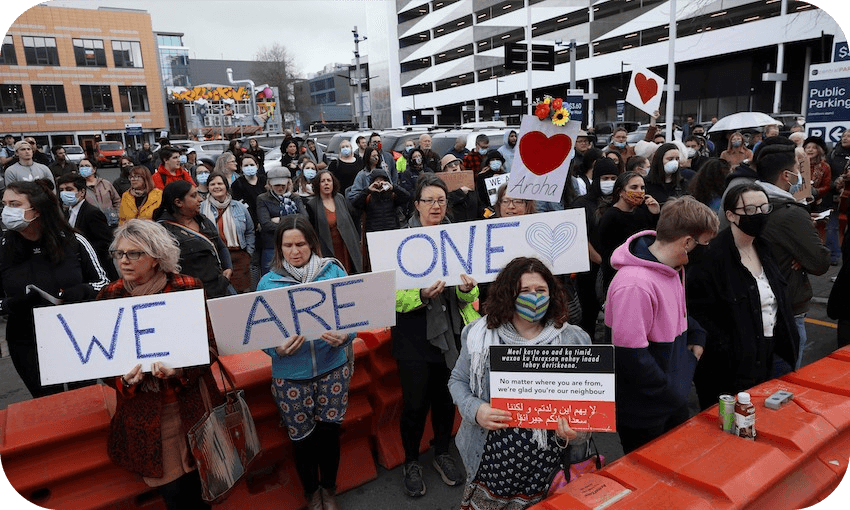The response to recommendations from the royal commission of inquiry into the March 15 attacks is a hopeful first step towards building stronger communities, writes Anjum Rahman.
Social cohesion is a fancy term, with many definitions. The Royal Commission of Inquiry into the Terrorist Attacks on Christchurch Masjidain (RCOI) noted a comprehensive definition that included:
- belonging – a sense of being part of the community, trust in others and respect for law and human rights;
- inclusion – equity of opportunities and outcomes in work, income, education, health and housing;
- participation – involvement in social and community activities and in political and civic life;
- recognition – valuing diversity and respecting differences; and
- legitimacy – confidence in public institutions.
At a basic level, people often think of social cohesion as space where we all agree with each other, we all think the same way and have similar values and cultural touchpoints. For me, social cohesion is about how we get along when we vehemently disagree on the most fundamental aspects of life, of society, of morality. It is about valuing the humanity of each person, about making space for each other.
That, in itself, is the one value judgement we need to agree on. Popper’s paradox of tolerance (that “in order to maintain a tolerant society, the society must be intolerant of intolerance”) is the space where social cohesion stands or falls. Building that first space of consensus is never easy, and it’s not one into which governments can and should venture.
Having the government develop a social cohesion strategy holds the danger of social engineering, of telling us how to think and act. This is never a good place for any state to be.
If this is the case, what is the purpose of a social cohesion framework? As someone who was part of the Social Cohesion Working Group and gave advice to MSD, the purpose is to guide communities in the way they organise and take action. It’s a resource that any community, not-for-profit, public sector or corporate entity can use to build belonging, inclusion, participation, recognition and legitimacy.
This is the greatest challenge with the framework. After so many months of hard work, a lack of uptake will mean the framework is a failure. A lack of investment at all levels will result in a lack of meaningful change.
On the other hand, when we have communities that are fracturing and divisive in ways that lead to violence, both physical and psychological, government has the resources to be able to develop strategies that keep us safe from harm while allowing political dissent, testing of ideas through debate and dialogue, and protecting the freedoms we expect in a democratic society.
In developing the social cohesion framework, the Ministry of Social Development began a process of comprehensive consultation, along with convening a representative working group. These engagements allowed for a diverse range of communities to shape the framework.
This was not a full co-design process, as key decision points sat with government agencies. The Royal Commission Of Iinquiry into March 15 recommended that “the public sector mindset must shift to value communities’ input into decisions, transparency and engaging in robust debate”. To that extent, MSD took comprehensive feedback to develop the framework, list action points and think about monitoring and evaluation tools to see if we were improving as a society.
There are many for whom social cohesion is not a problem. Systems, institutions, cultural values and norms all fit in their lifestyles and beliefs. They succeed materially and otherwise because society is set up for them. They see change as a threat, they approach it with fear and defensiveness. These fears are exacerbated by actors who benefit from the status quo and see change as a loss of social and economic status and power.
Until those who benefit most from the current systems are willing to change it, social cohesion will be a failed experiment. This is the place where government can lead: by applying social cohesion to itself, to the public servants and politicians that design and uphold systems, set policy and make decisions about the allocation of public resources.
Leading by example is critical, across the political spectrum. We see too often, both here and overseas, political actors who exploit divisions or create them, in order to achieve political power. Presenting a targeted group as a threat to “our way of life” unfortunately remains an effective political tool.
Ultimately this is about safety and equity for all of us. It’s about caring enough about all the people who live on this whenua. It is about embracing and enacting Te Tiriti o Waitangi as a pathway forward, for without justice and equity for tangata whenua, there can not be justice and equity for the rest of us.
The launch of a framework is a first small step. It is a small change in the way policy is developed, with other government departments also moving to more participation from communities. They need to go further, although it is difficult to do so in a political environment that brutally punishes failure. For the public service to relinquish control and trust communities to be the author of their own solutions is a fundamental design shift and requires a much higher level of investment and risk.
I’m quietly hopeful that we might get there. Discordant voices tend to be the loudest, but in our interactions with people in communities, there is a strong desire for us to move to a place where we can respect and value each other. Where we can find ways to build consensus while allowing each other the space to be true our own sense of self.





